International
RSSU Chess Cup
27.01.2012 - 05.02.2012. Moscow, Russia
27.01.2012 - 05.02.2012. Moscow, Russia
Tournaments↓
D. RSSU Student Grandmaster Cup (men)
Sicilian defence. Maroczy variation.
Round 3
1. e4 c5 2. Nf3 Nc6 3. d4 cd 4. Nd4 g6 That sequence of moves allows Black to avoid theoretical argument in the main branches of the Dragon Variation but assumes Maroczy variation, which mean to occupy central positions, moving с2-с4. 5. c4 The game now gains features of the English Opening. 5... Nf6 6. Nc3 Nd4 Exchanging pieces is useful to the side which lacks space. Exchanging Knights is more often applied after included moves 6...d6 7.Be2. But in that case White can avoid simplifications making 7.Nc2!? 7. Qd4 d6 8. Be2
8... Bg7 9. Bg5 O-O 10. O-O
[One of the basic "tabiya" of the variation appears after 10. Qd2 Be6 11. Rc1 Qa5 12. f3 Rfc8 13. b3 a6 14. Na4 Qd2 15. Kd2 Nd7 and so on. The move in the text leads to more uncommon positions.]
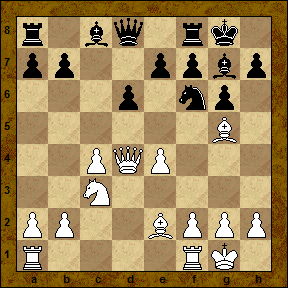
10... h6 Black resists the balanced repositioning of White (Qd2+ Bg5), weakens pawn defense of King.
[Alternative is 10... Be6 , for example 11. Qd2 (11. Qe3 Qb6!?) 11... Qa5 (Too soon 11... Rc8 12. b3 b5?! considering 13. e5!) 12. Rac1 a6 13. Rfe1 Rfc8 14. b3 b5 15. Bf3 Rab8 16. Nd5 Qd2 17. Bd2 Bd5 18. cd Nd7 19. Bg4 Rc1 20. Rc1 Nc5 21. f3 b4 with the safe position of Black, Mamediarov - Tivyakov, Germany 2009.]
11. Bd2 Be6 12. Qd3
[As an answer to 12. Qe3 possible is 12... Qb6 . And now Black Knight moves to its common in such situations position - square с5.]
12... Nd7 13. b3 Nc5 14. Qe3 Bd7 Bishop seeks to occupy с6, which enforces central impact of Black (for example pawn е7 gets freedom to move). 15. Rad1 a5
[Worth attention was 15... Bc6!? , slowing down the promotion f2-f4, and to 16.b4 possible answer is 16...Na4. 16. b4 Na4 17. Nb5 a6 18. Nd4 Bd7]
16. f4 Bc6
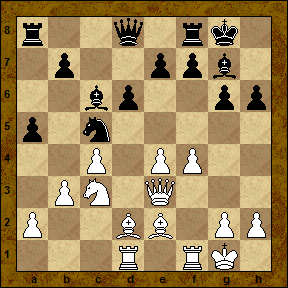
17. e5! It turns out that appearing "clumsy" Queen е3 "conducts" activity of White in the center! 17... Nd7 18. ed ed 19. Qg3
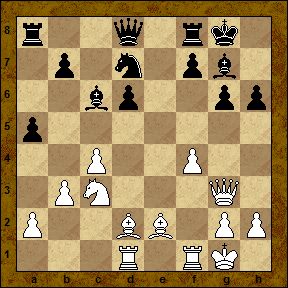
Problems of the Black pawn structure caused by the breakthrough е4-е5, are compensated by the active positioning of its Bishops. Worth attention was 19...a4!?, bothering competitor’s Queen side and bringing Rook into action а8. 19... Re8?! Too common continuation, letting White consolidate in the center. 20. Bf3 Nf6 21. f5! Underlining the move’s disadvantages h7-h6. 21... Kh7
[To 21... g5 possible answer is 22. h4]
22. fg fg

23. Bf4
[Now an unexpected strike was possible 23. Bh6! – prototype of the combination that happened later in the game. For example: 23... Kh6 (or 23... Bh6 24. Rd6 Qe7 (24... Qb6 25. Kh1 Bg7 26. Nd5!) 25. Bc6 Qe3 26. Qe3 Be3 27. Kh1 bc 28. Rdf6 Bd4 29. R6f3±) 24. Rd6 Qb6 25. Kh1 (thretening 26.Qh4+ Nh5 27.Q:h5X) 25... Qc5 26. Nd5! , and the White’ attack is unstopable.]
23... Qb6 24. Kh1 Rad8 25. Qh3
[Capturing pawn d6 was useless considering 25. Rd6 Rd6 26. Bd6 Bf3 27. c5 Bg2;
or 25. Bd6 Bf3 26. c5 Bg2]
25... Bf3 26. Qf3 The better pawn structure gives White obvious position advantage. 26... Re6 Allows White to implement a beautiful combination.
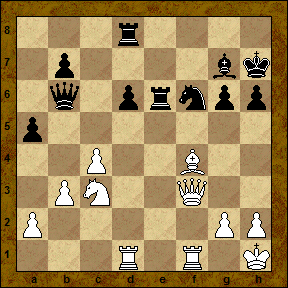
27. Bh6!! Effective strike! 27... Bh6
[or 27... Kh6 28. Qh3]
28. Nd5 Nd5 29. Qf7 Bg7 30. Qe6 Ne3
[Considering 30... Nc7 31. Qg4 the Black position is vulnerable.]
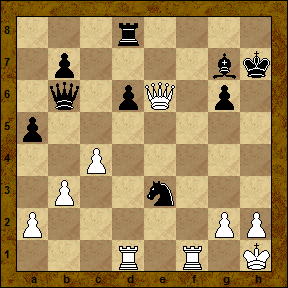
31. Rd3! Combination is in process. 31... Nf5 32. Rf5 [...]
[After 32... gf 33. Qf5 Kg8 34. Qe6 Black King is mated.]
[1:0]
Chess federation of a city of Moscow 2008-2010. © All rights reserved. It is made in RSSU